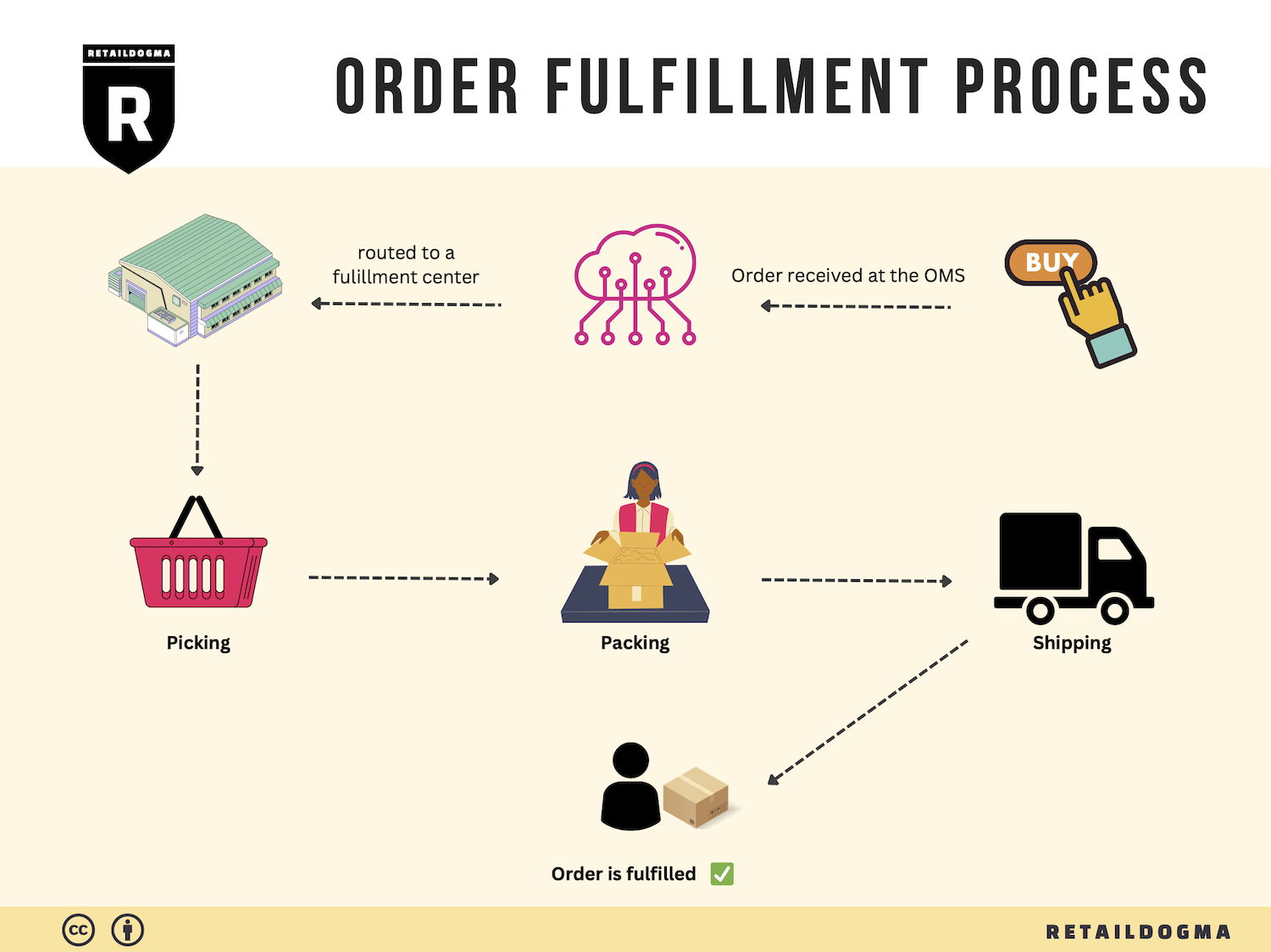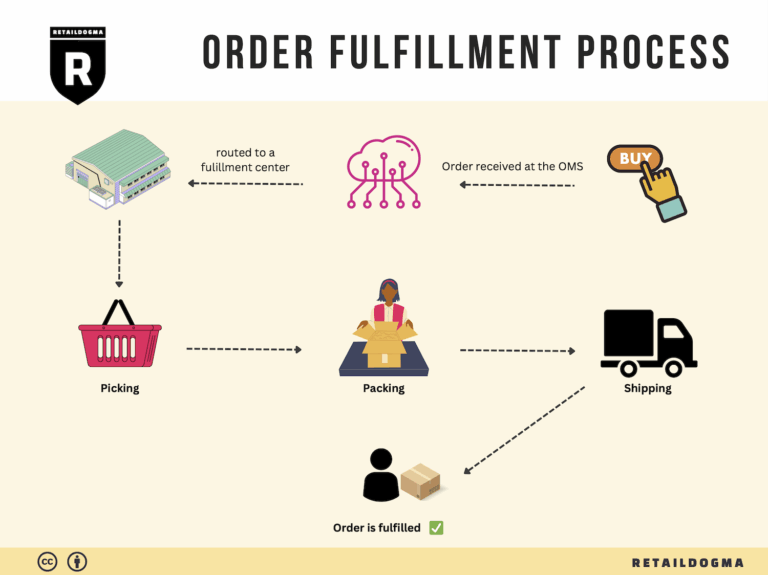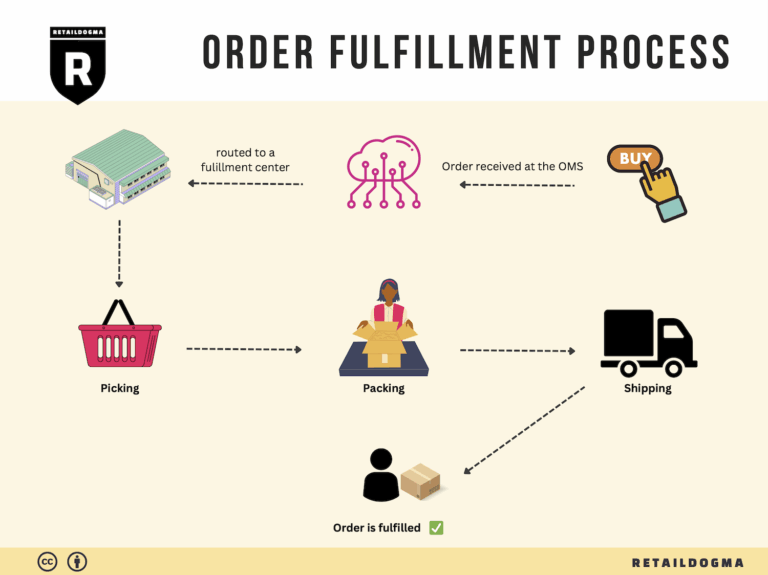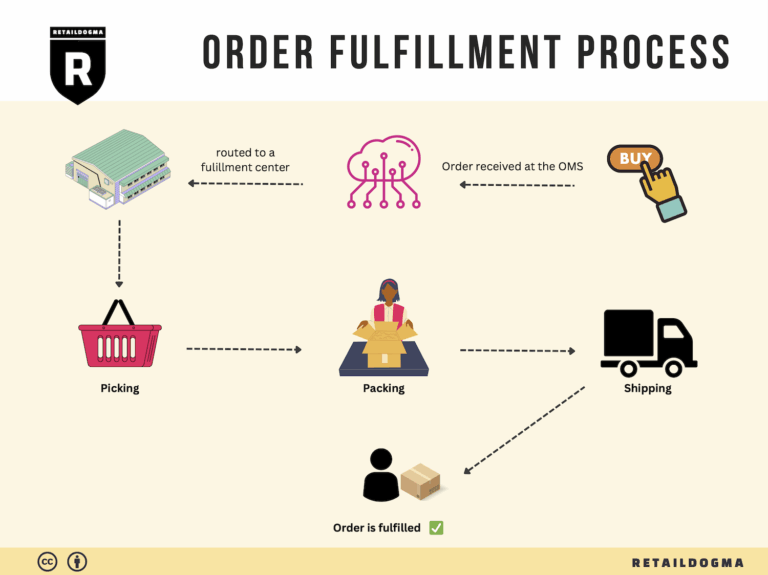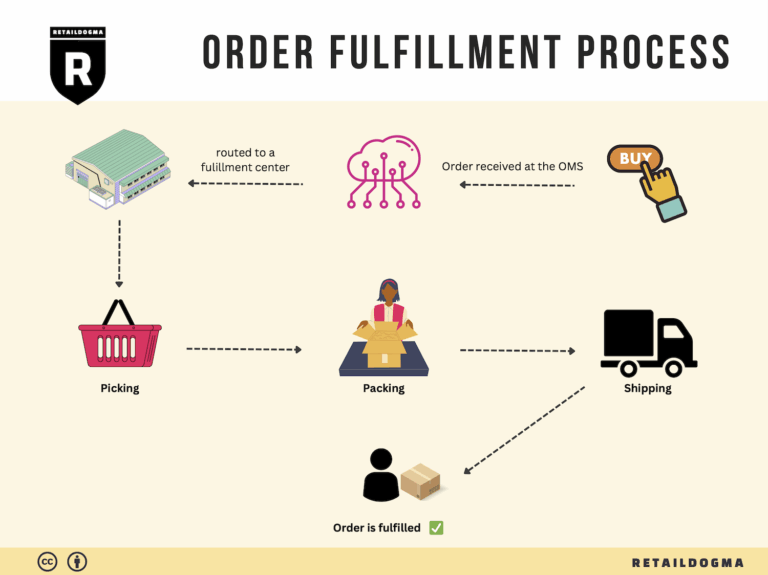How Order Fulfillment Works: A Step-by-Step Guide for Businesses
What is E-commerce Fulfillment? An Introduction for Growing Businesses
Understanding the Challenges of Order Fulfillment
As e-commerce business owners, many of you may find yourselves grappling with one of the most daunting aspects of running an online store: the fulfillment process. The overwhelming tasks of packing orders, managing inventory, and shipping products can quickly turn from a manageable responsibility into a significant source of stress. This challenge is particularly pronounced as your business scales, where the volume of orders can outpace your capacity to handle them efficiently.
What is E-commerce Fulfillment?
At its core, e-commerce fulfillment is the process of getting a product from your warehouse or fulfillment center to the customer’s doorstep. This encompasses a range of activities, including inventory management, order processing, packing, shipping, and handling returns. A well-structured fulfillment process is crucial for maintaining customer satisfaction and ensuring repeat business, as timely and accurate deliveries are often a key differentiator in the competitive online marketplace.
What This Guide Will Cover
In this guide, we will explore several critical aspects of e-commerce fulfillment, particularly tailored for growing businesses. We will examine different fulfillment models, such as Third-Party Logistics (3PL) and Fulfilled by Amazon (FBA), which can offer scalable solutions tailored to your specific needs.
Furthermore, we will delve into the core services that these fulfillment partners offer, including warehousing, shipping options, and order tracking. Understanding these services will help you determine which partner aligns best with your operational requirements and business goals.
Choosing the right fulfillment partner is a pivotal decision that can significantly impact your logistics efficiency and customer experience. We will provide practical tips on evaluating potential partners, including key factors to consider, such as their technology, service offerings, and geographic reach.
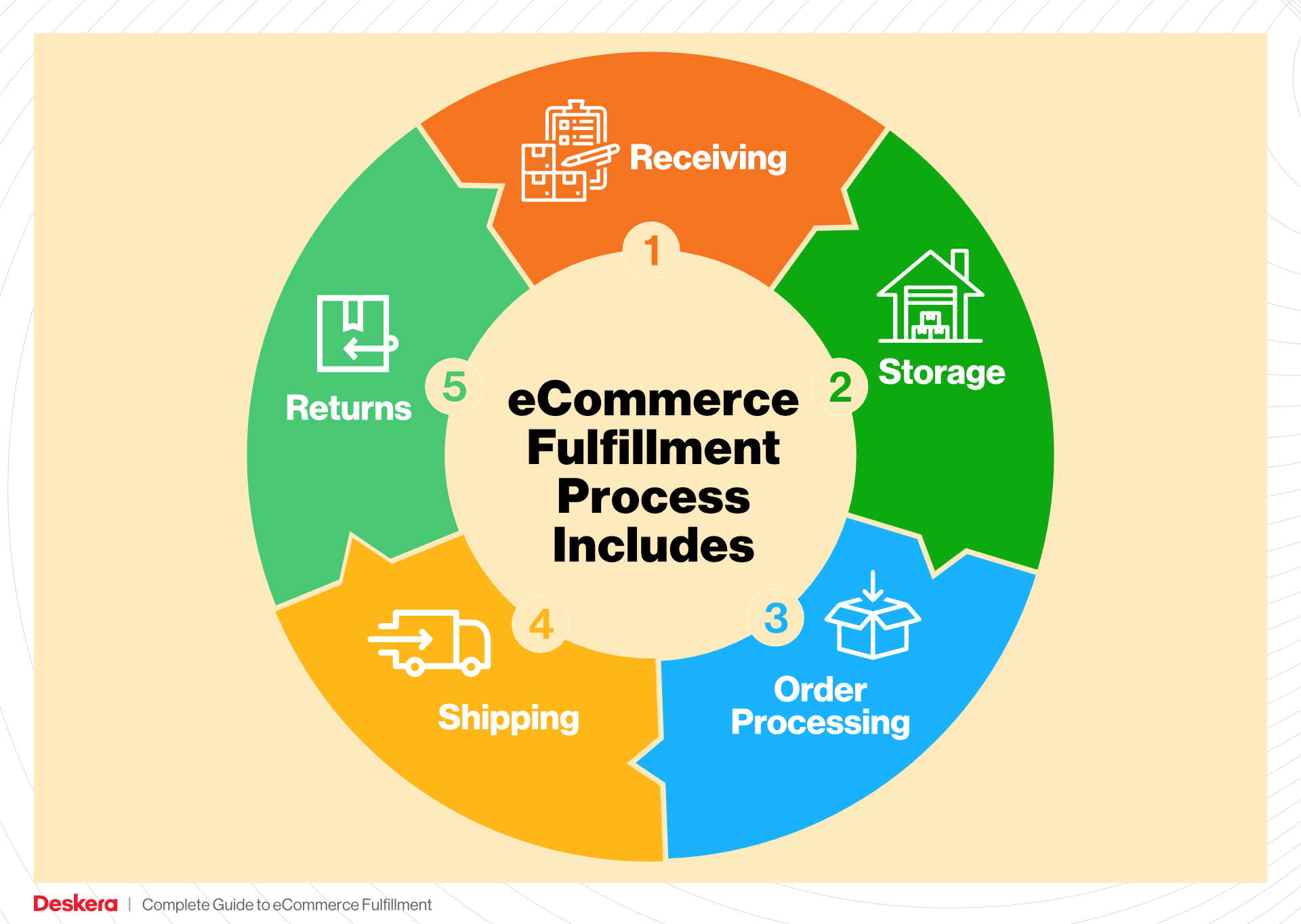
Additionally, pricing is an essential element of the fulfillment equation. We will break down the various cost structures you might encounter, helping you to budget appropriately and make informed financial decisions.
Empowering Your Business
Ultimately, this guide aims to empower e-commerce businesses like yours to make smart, strategic decisions about your logistics. By understanding the nuances of e-commerce fulfillment, you can streamline your operations, enhance customer satisfaction, and position your business for sustainable growth. Whether you are just starting or looking to refine your existing processes, this comprehensive overview will provide the insights you need to navigate the complexities of fulfillment with confidence.
What You’ll Learn In This Guide
- What is E-commerce Fulfillment? An Introduction for Growing Businesses
- The Order Fulfillment Process: From ‘Buy’ Button to Customer’s Door
- Comparing Fulfillment Models: In-House vs. 3PL vs. Dropshipping
- A Deep Dive into Amazon FBA: Pros, Cons, and Who It’s For
- Core Services Offered by Fulfillment Centers
- How to Choose a Fulfillment Partner: A 6-Point Checklist
- Understanding Fulfillment Pricing: A Breakdown of Common Fees
- Frequently Asked Questions (FAQs) about Fulfillment
- Conclusion: Is Outsourcing Fulfillment the Right Move for Your Business?
- Important Disclaimer
The Order Fulfillment Process: From ‘Buy’ Button to Customer’s Door
1. Receiving Inventory
The order fulfillment process begins with receiving inventory at the fulfillment center. This step involves accepting products from suppliers, manufacturers, or distribution centers. Upon arrival, each shipment is checked for accuracy against purchase orders and inspected for quality. This ensures that the correct items and quantities are received and that they meet the required standards.
Importance: Effective inventory receiving is critical because it establishes the foundation for all subsequent steps. Errors at this stage can lead to stock discrepancies, fulfillment delays, and ultimately dissatisfied customers.
Key Term: SKU (Stock Keeping Unit) – A unique identifier for each product that helps track inventory levels and manage stock efficiently.
2. Warehouse Storage
Once inventory is received and verified, it is stored in the fulfillment center. Products are typically organized in a systematic manner, often categorized by type, size, or sales frequency. This organization may include shelving units, pallet racks, and bins, all designed to maximize space and efficiency.
Importance: Proper warehouse storage is essential for optimizing space and ensuring that products are easily accessible for the next steps in the fulfillment process. Well-organized inventory reduces the time spent locating items, ultimately speeding up order processing.
Key Term: ABC Analysis – A method used to categorize inventory into three classes (A, B, and C) based on importance, sales velocity, or value, allowing for more focused management of high-demand items.
3. Order Picking
Order picking is the process of retrieving items from the warehouse to fulfill customer orders. This step typically involves generating a pick list, which details the items and quantities needed for each order. Warehouse staff then use this list to locate and gather the products.
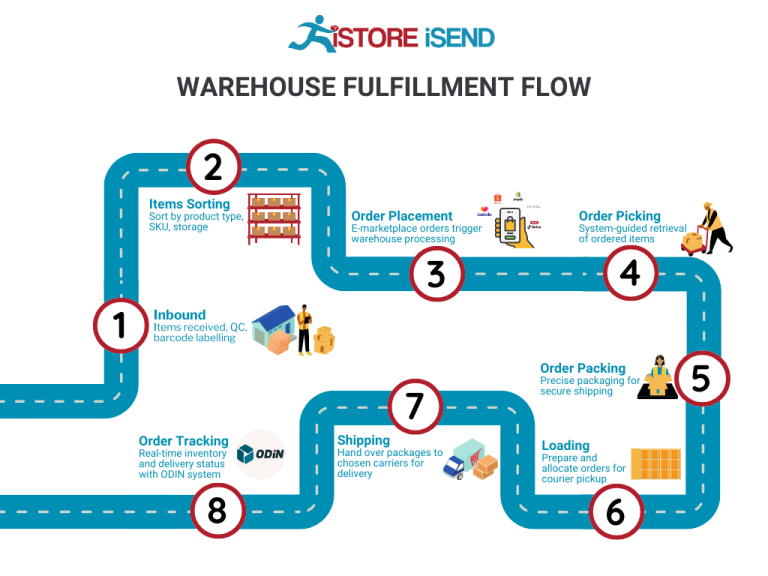
Importance: Efficient order picking is crucial for reducing lead times and ensuring that customers receive their orders quickly. The accuracy of this step directly affects customer satisfaction, as errors can lead to wrong items being shipped or delays in delivery.
Key Term: Pick Lists – Documents that outline the items to be picked for an order, including their locations within the warehouse, which streamline the picking process and enhance accuracy.
4. Order Packing
After items have been picked, they are moved to the packing station where they are prepared for shipment. This step involves checking the items for quality once more, packing them securely in appropriate materials, and labeling each package with shipping information.
Importance: Effective packing ensures that products arrive at their destination undamaged and in good condition. It also plays a role in the overall customer experience; a well-packaged order reflects professionalism and care.
Key Term: Packing Slip – A document included in the package that details the items enclosed, serving as a receipt and confirmation for the customer.
5. Shipping & Delivery
The final step in the order fulfillment process is shipping and delivery. Once packages are packed, they are scheduled for dispatch through various carriers, depending on the chosen delivery method (e.g., standard shipping, express delivery, or in-store pickup). The fulfillment center coordinates with logistics partners to ensure timely and accurate delivery.
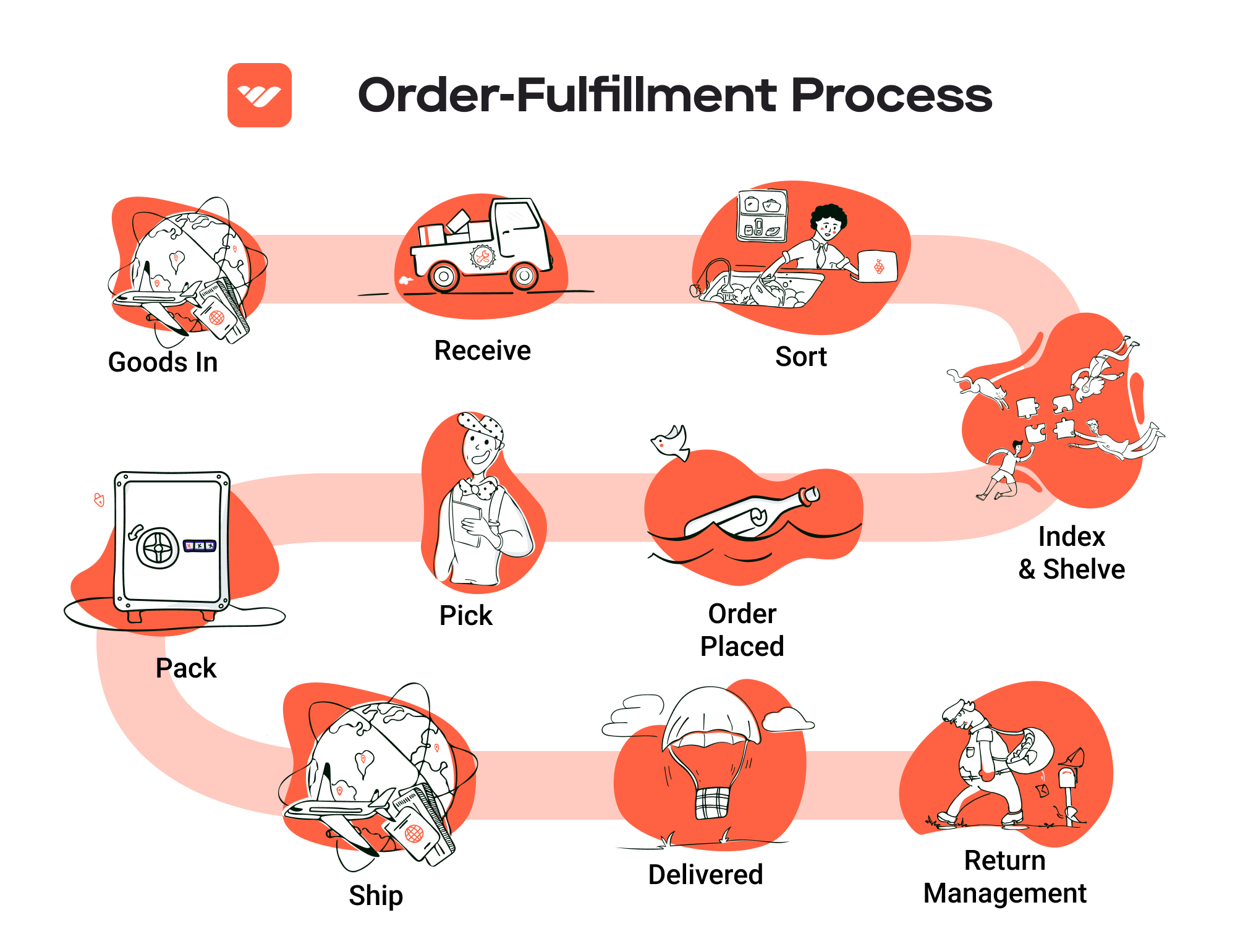
Importance: This step is the culmination of the entire fulfillment process and directly impacts customer satisfaction. Timely and accurate delivery can enhance the customer’s perception of the brand and encourage repeat business.
Key Term: Last-Mile Delivery – The final step of the delivery process where the package is transported from a transportation hub to the final delivery destination, often presenting the greatest challenges in logistics.
By understanding and optimizing each of these steps in the order fulfillment process, e-commerce businesses can improve their operational efficiency, enhance customer satisfaction, and ultimately drive sales growth. Each step is interconnected, and attention to detail at every stage is essential for successful order fulfillment.
Comparing Fulfillment Models: In-House vs. 3PL vs. Dropshipping
Fulfillment Model Comparison Table
| Model | Who Handles Inventory | Best For (Business Stage) | Key Advantage | Key Disadvantage |
|---|---|---|---|---|
| In-House Fulfillment | The business itself | Startups to established | Full control over inventory and operations | High upfront costs and operational complexity |
| Third-Party Logistics (3PL) | A third-party provider | Rapidly growing businesses | Scalability and expertise in logistics | Less control over inventory and fulfillment |
| Dropshipping | Supplier or manufacturer | New and small businesses | Low startup costs and no inventory risk | Lower profit margins and reliance on suppliers |
In-House Fulfillment
In-house fulfillment involves managing all aspects of the order fulfillment process internally. This model is commonly adopted by businesses that have the resources and capacity to handle storage, inventory management, order picking, packing, and shipping without outsourcing these functions. The primary advantage of in-house fulfillment is the level of control it affords a business. Companies can maintain tight oversight over their inventory levels, quality control, and shipping timelines, leading to potentially faster delivery times and improved customer satisfaction. However, this model also comes with significant challenges. The initial investment in warehouse space, technology, and staffing can be substantial. Additionally, as order volumes increase, the complexity of operations can grow, requiring the business to invest in more sophisticated logistics solutions and management systems.
Third-Party Logistics (3PL)
Third-party logistics (3PL) providers offer a comprehensive solution for businesses looking to outsource their fulfillment processes. This model is particularly beneficial for companies experiencing rapid growth or seasonal fluctuations in demand. By partnering with a 3PL, businesses can leverage the provider’s expertise in logistics and warehousing, allowing them to scale operations without the need for significant upfront investments. 3PLs typically handle everything from inventory storage and order processing to shipping and returns management. The key advantage of this model is its scalability; as your business grows, a 3PL can easily adjust its services to meet your needs. However, the trade-off is a reduction in control over inventory management and fulfillment processes. Businesses must rely on their 3PL partner to maintain quality standards and meet delivery deadlines, which can lead to challenges if the provider does not meet expectations.
Dropshipping
Dropshipping is a fulfillment model that allows businesses to sell products without holding any inventory. Instead, when a customer places an order, the business purchases the item from a third-party supplier, who then ships it directly to the customer. This model is particularly appealing to new or small businesses due to its low barriers to entry and minimal financial risk. Entrepreneurs can start an e-commerce store without investing in inventory upfront, which helps conserve cash flow. Additionally, dropshipping allows for a broad product offering without the need to manage stock levels. However, the downsides include lower profit margins, as suppliers typically charge wholesale prices that leave little room for markup. Moreover, businesses are reliant on suppliers for inventory quality and shipping times, which can lead to customer dissatisfaction if issues arise. As a result, while dropshipping can be an effective way to enter the e-commerce space, it requires careful supplier selection and management to ensure a positive customer experience.
Conclusion
Each fulfillment model presents unique advantages and challenges that can significantly impact an e-commerce business’s operations and growth potential. Choosing the right model depends on various factors, including the stage of the business, the nature of the products being sold, and the available resources. As businesses scale, they may find that a hybrid approach—combining elements of in-house fulfillment and 3PL or dropshipping—can provide the flexibility and efficiency needed to meet customer demands while managing costs effectively. Understanding these models and their implications will enable e-commerce entrepreneurs to make informed decisions that align with their operational goals and customer service commitments.
A Deep Dive into Amazon FBA: Pros, Cons, and Who It’s For
Understanding Fulfillment by Amazon (FBA)
Fulfillment by Amazon (FBA) is a service provided by Amazon that allows sellers to store their products in Amazon’s fulfillment centers. Amazon then takes care of storage, packaging, and shipping of the products directly to customers. This service is particularly beneficial for e-commerce businesses looking to scale operations without the burden of managing logistics. Sellers simply need to ship their products to Amazon’s warehouses, and Amazon handles the rest, including customer service and returns.
How FBA Works
-
Sign Up: To begin using FBA, sellers must have an Amazon seller account. They can then enroll in the FBA program.
-
Ship Products to Amazon: Sellers prepare their products according to Amazon’s guidelines and ship them to designated fulfillment centers. Amazon provides shipping labels and guidelines to streamline this process.
-
Storage: Once the products arrive at the fulfillment center, they are stored until an order is placed. Amazon’s sophisticated inventory management system keeps track of stock levels.
-
Order Fulfillment: When a customer places an order for a product that is fulfilled by FBA, Amazon picks, packs, and ships the item directly to the customer. This process is efficient, often resulting in same-day or next-day delivery options for Prime members.
-
Customer Service: Amazon manages all customer service inquiries and returns for FBA products, allowing sellers to focus on other aspects of their business.
Pros of Fulfillment by Amazon
1. Prime Eligibility
FBA products are automatically eligible for Amazon Prime, which can significantly increase sales. Prime members tend to spend more and are more likely to choose Prime-eligible products due to the benefits of free shipping and faster delivery.
2. Customer Trust
Amazon is a well-established brand known for its customer service and reliability. By using FBA, sellers can leverage Amazon’s reputation, which can instill trust in potential buyers. Products fulfilled by Amazon often benefit from higher conversion rates due to this trust factor.
3. Multi-Channel Fulfillment
FBA offers the flexibility of multi-channel fulfillment, allowing sellers to fulfill orders from other sales channels (like their own website) using Amazon’s fulfillment services. This can streamline operations and ensure consistency in shipping and handling.
4. Scalability
FBA allows sellers to scale their businesses without the need to invest in their own warehousing and logistics. As demand grows, sellers can send larger quantities of products to Amazon’s fulfillment centers without worrying about storage space or shipping logistics.
5. Time Savings
By outsourcing fulfillment to Amazon, sellers can save valuable time and focus on other aspects of their business, such as marketing, product development, and customer engagement.
Cons of Fulfillment by Amazon
1. High Fees
One of the significant drawbacks of FBA is the cost. Amazon charges various fees, including storage fees for items held in their warehouses and fulfillment fees for each order processed. These fees can add up quickly, especially for sellers with low-margin products.
2. Strict Inventory Rules
Amazon has strict guidelines regarding inventory management. Sellers must comply with these rules to avoid penalties or account suspensions. This includes maintaining accurate stock levels, proper labeling, and adhering to expiration dates for perishable goods.
3. Commingling Risks
FBA operates on a commingling model, where inventory from different sellers may be mixed together in the same fulfillment center. This can pose risks, such as sellers receiving negative feedback due to issues with products that are not theirs, or complications arising from counterfeit products being shipped.
4. Limited Control Over Branding
When using FBA, sellers have limited control over the packaging and presentation of their products. Amazon’s generic packaging may not align with a seller’s branding strategy, which can affect brand recognition.
5. Dependency on Amazon
Relying on Amazon for fulfillment can lead to a lack of control over the customer experience. If Amazon experiences fulfillment delays or issues, it can directly impact the seller’s reputation and sales.
Who is FBA Best For?
FBA is an excellent option for various types of sellers:
-
Small to Medium-Sized Businesses: Companies looking to scale without the overhead of managing logistics and warehousing can benefit significantly from FBA. It allows them to focus on growth rather than operational challenges.
-
Retail Arbitrage Sellers: Those who buy discounted products and resell them online can leverage FBA to manage inventory and fulfill orders efficiently.
-
Established Brands: Brands looking to expand their reach and tap into Amazon’s vast customer base can use FBA to enhance their visibility and sales.
-
E-commerce Entrepreneurs: New sellers entering the e-commerce space can utilize FBA to simplify the logistics of selling online, allowing them to test products without heavy upfront investment in warehousing.
In conclusion, Fulfillment by Amazon offers a powerful tool for sellers looking to streamline their operations and enhance their sales potential. While there are costs and challenges associated with the service, the benefits of increased visibility, customer trust, and operational efficiency make it an attractive option for many e-commerce businesses.
Core Services Offered by Fulfillment Centers
Inventory Management & Warehousing
Fulfillment centers provide comprehensive inventory management and warehousing services, which are crucial for e-commerce businesses aiming to scale efficiently. This service involves the systematic organization, tracking, and storage of products within a facility. Fulfillment centers utilize advanced inventory management systems to monitor stock levels in real-time, ensuring that businesses are always aware of what items are available and when to reorder.
The benefits of effective inventory management are manifold. First, it minimizes the risk of overstocking or stockouts, both of which can severely impact cash flow and customer satisfaction. By having a clear view of inventory levels, e-commerce businesses can make informed purchasing decisions, optimizing their supply chain and reducing holding costs. Additionally, efficient warehousing practices allow for better space utilization, leading to reduced operational costs. For businesses looking to scale, this service ensures that they can handle increasing order volumes without compromising on service quality or operational efficiency.
Pick and Pack Services
Pick and pack services are a fundamental offering of fulfillment centers, streamlining the order fulfillment process. This service involves selecting items from the warehouse (picking) and packaging them for shipment (packing). When an order is received, fulfillment center staff quickly locate the products, prepare them for shipping, and ensure they are packed securely to prevent damage during transit.
The primary benefit of pick and pack services is speed and accuracy. With a dedicated team and efficient processes in place, fulfillment centers can significantly reduce order processing times, allowing businesses to offer faster shipping options to their customers. This is particularly important in today’s e-commerce landscape, where consumers increasingly expect quick delivery. Furthermore, outsourcing this function allows e-commerce businesses to focus on core activities such as marketing and product development, rather than getting bogged down in logistics. As a result, they can enhance customer satisfaction and retention by providing reliable and timely order fulfillment.
Kitting and Assembly
Kitting and assembly services offered by fulfillment centers allow e-commerce businesses to combine multiple products into a single package, enhancing the customer experience and increasing perceived value. This service is particularly useful for businesses that sell products that are often purchased together or require assembly before use, such as furniture or DIY kits. Fulfillment center staff can assemble these kits or products according to specific requirements, ensuring that all components are included and correctly packaged.
The benefits of kitting and assembly are significant. First, it can lead to increased sales through bundled offers or promotions, encouraging customers to purchase more items at once. Additionally, it simplifies the purchasing process for customers, as they receive a complete solution rather than having to buy individual components separately. This not only enhances customer satisfaction but can also lead to higher average order values. For e-commerce businesses, this service can streamline operations and reduce the complexity of inventory management, as well as provide a competitive edge in the marketplace.
Returns Management (Reverse Logistics)
Returns management, often referred to as reverse logistics, is an essential service provided by fulfillment centers that focuses on handling product returns efficiently. This involves processing returns, restocking items, and managing any necessary repairs or refurbishments. An effective returns management system is vital for maintaining customer trust and satisfaction, especially in the e-commerce sector where return rates can be high.
The benefits of a robust returns management process are twofold. Firstly, it helps businesses maintain a positive relationship with customers by making the return process straightforward and hassle-free. Customers are more likely to shop with a brand that offers easy returns, which can enhance customer loyalty and repeat purchases. Secondly, efficient returns processing can minimize losses associated with returned goods. By quickly restocking items and assessing their condition, fulfillment centers can help businesses recover revenue and reduce the impact of returns on their bottom line.
In summary, fulfillment centers offer a suite of core services that are integral to the success of e-commerce businesses looking to scale. From inventory management and warehousing to pick and pack services, kitting and assembly, and returns management, these services enable businesses to operate more efficiently, enhance customer satisfaction, and ultimately drive growth. By leveraging the expertise and resources of fulfillment centers, e-commerce owners can focus on strategic initiatives and scaling their operations without getting bogged down in the complexities of logistics.
How to Choose a Fulfillment Partner: A 6-Point Checklist
Location & Warehouse Network
The geographical location of your fulfillment partner’s warehouses can significantly impact shipping times and costs. A partner with a well-distributed network allows for quicker deliveries and lower shipping expenses, especially if your customer base is widespread.
Questions to Ask:
– Where are your warehouses located, and how many do you operate?
– What are your average shipping times to major regions?
– Do you have plans for expanding your warehouse network?
Understanding the logistics of their locations helps ensure that your products reach customers promptly and efficiently, which can enhance customer satisfaction and retention.
Technology & Integrations
In today’s e-commerce landscape, technology plays a crucial role in streamlining operations. Your fulfillment partner should offer robust technology solutions that integrate seamlessly with your existing platforms, such as your e-commerce website, inventory management system, and customer relationship management tools.
Questions to Ask:
– What technology do you use to manage inventory and orders?
– Can your system integrate with my e-commerce platform (e.g., Shopify, WooCommerce)?
– Do you provide real-time tracking and reporting tools for order status?
A partner with advanced technology can automate processes, reduce human error, and provide insights into your operations, ultimately leading to better decision-making and efficiency.
Specializations (e.g., Cold Storage, Oversized Items)
Depending on your product offerings, you may require a fulfillment partner with specialized capabilities. If you sell perishable goods, for example, ensure your partner has the necessary cold storage facilities. Similarly, if you deal with oversized items, check that they have the means to handle such products without incurring excessive costs.
Questions to Ask:
– What types of specialized storage do you offer (e.g., cold storage, hazardous materials)?
– How do you handle oversized or bulky items?
– Are there additional fees for specialized storage or handling?
Selecting a partner with the right specializations ensures your products are stored and shipped correctly, maintaining quality and compliance with regulations.
Scalability & Capacity
As your business grows, your fulfillment needs will likely change. Your partner should be able to scale operations to accommodate increased order volumes, seasonal spikes, or new product lines without compromising service quality.
Questions to Ask:
– How do you handle peak seasons or sudden increases in order volume?
– Can you accommodate seasonal inventory fluctuations?
– What is your maximum capacity for order fulfillment?
A partner that can grow with you reduces the risk of operational bottlenecks and ensures you can meet customer demand without delays.
Pricing and Contracts
Understanding the pricing structure and contract terms of your fulfillment partner is critical for budgeting and financial planning. Look for transparency in pricing and ensure that there are no hidden fees that could impact your bottom line.
Questions to Ask:
– What is your pricing model (e.g., per order, per item, monthly fees)?
– Are there any additional fees for services such as storage, picking, or shipping?
– What is the contract length, and are there options for termination or renegotiation?
Being clear on pricing and contract terms helps you avoid unexpected costs and allows for better financial forecasting as your business evolves.
Customer Support & Reviews
The level of customer support provided by your fulfillment partner can greatly influence your experience and the satisfaction of your customers. Responsive and knowledgeable support is essential for resolving issues promptly and maintaining smooth operations.
Questions to Ask:
– What support channels do you offer (e.g., phone, email, live chat)?
– What are your typical response times for customer inquiries or issues?
– Can you provide references or testimonials from current clients?
Researching reviews and testimonials can provide insights into the reliability and performance of the fulfillment partner. A partner with a solid reputation for customer support will help you navigate challenges more effectively.
Conclusion
Choosing the right fulfillment partner is crucial for the success of your e-commerce business. By thoroughly evaluating potential partners against this checklist, you can ensure that you select a fulfillment provider that aligns with your operational needs, enhances customer satisfaction, and supports your growth ambitions. Take the time to ask the right questions and seek clarity on each point to make an informed decision that sets your business up for success.
Understanding Fulfillment Pricing: A Breakdown of Common Fees
Initial Setup Fees
Initial setup fees are typically charged when you first establish your account with a fulfillment center. These fees cover the costs associated with onboarding your business, including account creation, system integration, and any necessary training. The amount can vary widely depending on the complexity of your operations and the specific services offered by the fulfillment center.
Calculating initial setup fees often involves a flat rate or a tiered structure based on the volume of products you plan to store and ship. Some fulfillment centers may also charge additional fees for customizations, such as integrating your e-commerce platform with their inventory management system or creating branded packaging.
Receiving Fees
Receiving fees are charged for the process of accepting and logging inventory into the fulfillment center. This fee usually includes the labor involved in unloading, inspecting, and storing your products.
These fees can be calculated on a per-pallet or per-box basis, and they may vary depending on the complexity of the items being received. For instance, larger or more complex items may incur higher fees due to the additional handling required. It’s essential to provide accurate product details to the fulfillment center to avoid unexpected receiving fees.
Storage Fees (per pallet/bin)
Storage fees are incurred for the space your inventory occupies within the fulfillment center. These fees are usually charged on a monthly basis and can be calculated per pallet, bin, or shelf space utilized.
Factors influencing storage fees include the size and type of products being stored. For example, bulky items may take up more space and thus incur higher fees. Additionally, some fulfillment centers offer tiered pricing, where the rate decreases as you store more inventory. It’s crucial to monitor your inventory levels to minimize storage fees by avoiding excess stock.
Pick & Pack Fees (per item/order)
Pick and pack fees cover the costs associated with selecting items from inventory and packing them for shipment. This fee is typically calculated on a per-item or per-order basis, depending on how the fulfillment center structures its pricing.
The calculation of pick and pack fees can be influenced by several factors, including:
- Item Complexity: Items that require special handling or packaging may incur higher fees.
- Order Volume: Larger orders may benefit from bulk pricing or reduced fees per item.
- Special Requests: Custom packing or additional services, such as gift wrapping, may attract extra charges.
Understanding how these fees work will help you optimize your order fulfillment process and control costs.
Shipping Fees
Shipping fees represent the costs associated with transporting orders from the fulfillment center to your customers. These fees can vary based on several factors, including shipping method (standard, expedited, etc.), package weight and dimensions, and destination.
Shipping fees are generally calculated using a combination of base rates from carriers and additional surcharges for specific services. Some fulfillment centers offer discounted shipping rates due to partnerships with major carriers, which can benefit businesses looking to reduce overall shipping costs.
Tips for Getting an Accurate Quote
-
Provide Detailed Information: When requesting a quote from a fulfillment center, provide as much detail as possible about your products, order volume, and specific requirements. This information will help the provider give you a more accurate estimate.
-
Ask About Fee Structures: Different fulfillment centers may have different pricing models. Inquire about whether they charge flat rates, tiered pricing, or variable fees based on specific factors.
-
Consider Hidden Fees: Ensure you understand all potential fees involved in the fulfillment process. Ask about additional charges for services like returns, special packaging, or order modifications.
-
Request a Trial Period: If possible, negotiate a trial period to assess the fulfillment center’s services and pricing structure. This will allow you to evaluate the actual costs and service quality before committing long-term.
-
Review Contracts Carefully: Before signing any agreements, review the terms and conditions thoroughly. Pay close attention to any clauses related to pricing adjustments, minimum volume commitments, or cancellation policies.
By understanding these common fulfillment pricing models and following these tips, e-commerce business owners can make informed decisions and select a fulfillment partner that aligns with their operational needs and budget constraints.
Frequently Asked Questions (FAQs) about Fulfillment
1. What is the Menards Fulfillment Center?
The Menards Fulfillment Center is a specialized facility designed to streamline the storage, picking, packing, and shipping of products ordered online. It ensures efficient order processing, allowing customers to receive their products quickly and reliably, whether through direct shipping or store pickup.
2. How does the fulfillment process work at Menards?
When an order is placed online, the Menards Fulfillment Center processes it by retrieving the items from inventory, packing them securely, and preparing them for shipment or pickup. Customers can choose various delivery options, including home delivery, store pickup, or local delivery, depending on their preferences.
3. What delivery options are available through Menards Fulfillment Center?
Menards offers multiple delivery options, including:
– Parcel Delivery: Items shipped directly to your preferred address.
– Free Shipping to Store for Pickup: Orders shipped to a local Menards store for customer pickup.
– Local Store Delivery: Direct delivery to a home or job site.
– Same Day/Next Day Delivery: Fast delivery through local courier services.
– In-Store Pickup: Customers can pick up items directly from the store or fulfillment center.
4. What is the difference between a warehouse and a fulfillment center?
A warehouse primarily focuses on storage, whereas a fulfillment center is designed for order processing and distribution. Fulfillment centers are equipped with systems and processes to handle picking, packing, and shipping efficiently, often including technology for inventory management and order tracking.
5. What is a 3PL (Third-Party Logistics)?
A 3PL provider offers outsourced logistics services, including transportation, warehousing, and fulfillment. Businesses often partner with 3PLs to manage their supply chain operations more effectively, leveraging the provider’s expertise and infrastructure to scale their logistics capabilities without the need to invest in their own facilities.
6. How much do fulfillment services cost?
Fulfillment service costs can vary widely based on factors such as order volume, storage needs, and specific services provided (e.g., packing, shipping). Typically, costs may include storage fees, picking and packing fees, and shipping charges. It’s essential for businesses to evaluate their needs and compare providers to find a cost-effective solution.
7. Can I track my order from the Menards Fulfillment Center?
Yes, Menards provides an order tracking feature that allows customers to monitor their order status from the time of purchase to delivery. Customers will receive tracking information via email, enabling them to stay informed about their shipment’s progress.
8. What items are eligible for delivery from Menards Fulfillment Center?
Most items available on the Menards website are eligible for delivery. However, certain items, particularly larger products like appliances or heavy materials, may have specific delivery options or restrictions. During checkout, customers will be informed of available shipping methods for their selected items.
9. What should I do if my order is damaged or incorrect?
If you receive a damaged or incorrect order, Menards has a straightforward return and exchange policy. Customers should contact Menards customer service as soon as possible to report the issue, and they will provide instructions for returning the item or receiving a replacement.
10. How can businesses benefit from using the Menards Fulfillment Center?
Businesses can benefit from the Menards Fulfillment Center by leveraging its efficient order processing and delivery systems, which can help improve customer satisfaction and streamline operations. By outsourcing fulfillment, businesses can focus on core activities like marketing and product development while relying on Menards to manage logistics effectively.
Conclusion: Is Outsourcing Fulfillment the Right Move for Your Business?
Evaluating the Benefits of Outsourcing Fulfillment
Outsourcing fulfillment can be a game-changer for e-commerce businesses seeking to scale operations efficiently. By leveraging a specialized fulfillment partner, businesses can significantly save time and resources. Fulfillment centers like Menards offer streamlined processes that handle inventory management, order processing, and shipping logistics, allowing business owners to focus on core activities such as marketing and customer engagement.
Moreover, outsourcing fulfillment provides the scalability needed to adapt to fluctuating demand. As your business grows, a capable fulfillment partner can seamlessly manage increased order volumes, ensuring that you can meet customer expectations without the burden of expanding your infrastructure. This flexibility is particularly advantageous during peak seasons when demand surges unexpectedly.
Additionally, partnering with an experienced fulfillment service brings invaluable expertise to your operations. These providers have established best practices and advanced technologies that optimize the fulfillment process, reducing errors and improving delivery times. Their knowledge of logistics can also help in navigating complexities like shipping regulations and international trade, which can be daunting for growing businesses.
However, it is crucial to choose the right fulfillment partner to support your growth trajectory. Factors such as location, service offerings, and technology integration should align with your business goals and customer needs. A misalignment can lead to inefficiencies and customer dissatisfaction, counteracting the benefits of outsourcing.
To determine if outsourcing fulfillment is the right step for your business, conduct a thorough audit of your current shipping process. Assess your order volume, delivery times, and customer feedback to identify pain points. This evaluation will guide your decision-making process and help you understand how a fulfillment partner could enhance your operational efficiency and customer satisfaction. Taking this proactive step may well position your business for sustainable growth in the competitive e-commerce landscape.
Important Disclaimer
⚠️ Important Disclaimer
The information in this guide is for educational purposes. Fulfillment services, pricing, and platform features change frequently. Always conduct your own due diligence and consult with providers directly before making business decisions.
